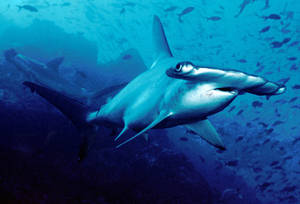Rome, 19 February 2015 – Sharks may be able to swim more serenely one day thanks to a handy new digital technique developed by the UN Food and Agriculture Organization (FAO) that allows for the quick identification of species of the iconic fish.*
The new iSharkFin software will help protect endangered shark species and combat illegal trade in shark fins.
It is a tool for custom officers and inspectors at fish markets as well as for fishermen keen on avoiding the capture of protected species, said Monica Barone, who led a team in FAO’s Fisheries and Aquaculture Department in the development of the software.
Work on the project began in 2013, after five shark species were added to the Convention on International Trade in Endangered Species of Wild Fauna and Flora (CITES).
How iSharkFin works
The system is based on machine learning techniques and provides expertise to port inspectors, custom agents, market inspectors and fish traders who lack formal taxonomic training.
A photograph is uploaded, the user then chooses several key points of the fin shape along with identifying a few other characteristics, and an algorithm compares the information with its memory bank and identifies the shark specie. The process takes about five minutes. FAO is developing an app version of iSharkFin that can be used with tablets or smart phones, broadening its potential reach and use.
So far the iSharkFin can identify 35 shark species from dorsal fins – the iconic one atop the animal’s spine – and seven from just the pectoral fins underneath.
Many of the types are those most frequently traded internationally. More will be added, but as some species are becoming quite rare, it takes time to gather an adequately complete data.
The software was developed by FAO in collaboration with the University of Vigo in Spain. CITES and the Government of Japan provided financial support.
Shark survival
Introducing iSharkFin may allow authorities to crack a long-running mystery over the actual magnitude of global shark fishing.
Estimates of the number of sharks killed vary enormously, with one new study suggesting the figure may be above 73 million, or more than 6 percent of the total stock each year. This number exceeds the rate considered sustainable for an animal that take a long time to mature and produce few offspring and four times higher than the figure recorded in FAO data based on official production statistics.
The enigmatically large gap is often blamed on “shark finning,” a practice involving slashing off a shark’s fins and dumping the animal back into the sea. Many nations have declared shark finning illegal and insist that shark fins may be traded only if the whole carcass is brought to shore.
Using iSharkFin should allow for a better understanding of the gap, as the data on photographed fins can be used to extrapolate the presumed volume and weight of the whole animal, leading to a back-door calculation of aggregate shark harvesting, said Barone.
The challenges of effective management in high seas areas, including responsible fishing and conservation of species at risk, are being discussed this week at a high-level workshop at FAO. Learn more. (*Source: FAO).










